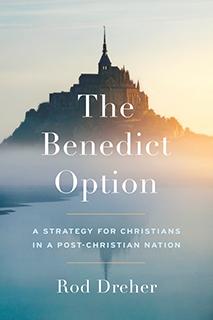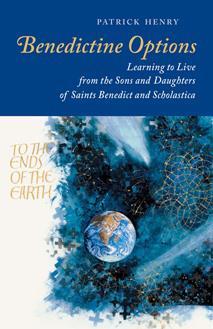
Tourists and townspeople surround a statue of St. Benedict Aug. 14, 2013, in the small Italian town of Norcia. (CNS/Henry Daggett)
Great cultural change — the kind that upends our social givens — always spawns division. More times than not, the changes create fissures among us that can lead to whole new contests of social interpretation.
Most interesting of all, perhaps, is the fact that religious orders are not extinct from the effects of social change and the risks of redefinition from age to age. If the multiple books on Benedictinism in this period are any proof, we're there.

Cover of "The Benedict Option: A Strategy for Christians in a Post-Christian Nation" (CNS)
For instance, Benedictinism, founded in the sixth century and so the oldest religious order in the church, has recently become the subject of public journalism. Rod Dreher, journalist and senior editor at The American Conservative presents Benedictinism in his 2018 book, The Benedict Option: A Strategy for Christians in a Post-Christian Nation, as a solution to the problems of the day.
And so, from a philosophical posture, do I. But differently.
The difference is that Dreher in his book defines Benedictinism as a way of separating ourselves from the larger society. To save ourselves from the dangers of secularism, Dreher puts it this way: "Now, Christians are going to have to purposefully seek out similarly committed Christians. We need to live near each other, educate our children together, employ each other, and support each other. … That is what it means to be an intentional community. We must be a community by choice, not by accident."
The Benedict Option may not be "a retreat from society," as Dreher insists, but it certainly is a call to a Christian segregation of sorts.
Patrick Henry, on the other hand, author of a forthcoming book in September on Benedictinism entitled Benedictine Options: Learning to Live from the Sons and Daughters of Saints Benedict and Scholastica, has, for as long as I have known him, had a capacity for essence.
So many people look at what's happening around them and declare that what they can see directly is what is. Henry, on the other hand, sees what is at the heart of it and how it is that it does what others cannot see.
There are, of course, a good many attempts to freeze Benedictinism into something that runs more on old customs than on tried but ancient values and a sense of enduring purpose. As the many Benedictines who struggled through those periods of redefinition themselves know, that strain mourns a past that never actually prevailed.

Cover to "Benedictine Options: Learning to Live from the Sons and Daughters of Saints Benedict and Scholastica"
Benedictinism, you see, is of the substance of every now. It takes life as it is and gives it goals to achieve from one culture to the next.
Indeed, Benedictinism goes on, not to reject the world around it, but to address the needs of the age. It is a tonic against the infections of the present. It is a sign of the possible. It is a beacon of life at its regular, quiet, productive best. Benedictinism does not run away from life; it provides a pattern for the achievable, however off-balance the present may have become. It leavens it.
And it is exactly there that Henry breaks open the essence of Benedictinism to the modern world. He shows us the elements of a spiritual tradition that is imbedded in the basics of life when the rest of the world tilts toward its extremes. He gives us Benedictine vectors to steer by — community, tradition, hospitality, productivity and stewardship — as well as an immersion in the spiritual heart of life. He presents Benedictinism as a mirror to the world around it as it defines and redefines itself from age to age.
Community, in Benedictine terms, is not a synonym for conformity, not a recipe for perfection, but a lifeline to the better.
We are in community to learn from the other what we do not know and to supply for the other what they need. We are there to do together what we cannot possibly do alone — which means come to the depth of ourselves and the growth of the world around us, both psychologically and spiritually. We are there to go beyond our self-centeredness to the gift of self-giving and immersion in the presence of God.
Tradition, too, in a Benedictine community is not a commitment to things "the way they have always been done." Tradition, the Benedictine knows after 1,500 years of immersing ourselves in it as we also immersed ourselves in every changing culture, is a commitment to maintain the bedrock values of the past in ways that make them sensible today. Tradition is the well of spirituality — The Rule of St. Benedict and all its values — from which the Benedictine draws.
Clearly, if the "tradition" has anything do with the spiritual core of what it means to be a Benedictine today, the deification of past paraphernalia can hardly be anything more than an obeisance to traditionalism.
Hospitality — the bridge between the monastery and the world — welcomes the world around it and refuses to allow the community to grow stale. The rule says: "At the door of the monastery, place a sensible old man who knows how to take a message and deliver a reply, and whose age keeps him from roaming about." The loose translation of it is clear: Bless you for interrupting our perfect little lives so that we can realize our obligations to the world around us. Otherwise, we may only live to define our own comfort, to block the only real gift we have to give, the proof of the power of the spiritual in life.
Advertisement
Productivity — the obligation of Benedictines to "earn our bread by the work of our hands just as our ancestors before us" — leaves no room for depending on others to support us just because we're "religious." Our lives must also mean something to others. Some monasteries, for instance, began over time to sell cheeses or chocolates or make vestments or icons or Communion hosts to support their communities. Then, as the centuries went by, they began to add ministries like winemaking, schools on all levels, and hospitality and spirituality centers as institutions of welcome.
Yet, in the end, it is its spirit, not its industries, that are the cement of Benedictine life. Work binds the community itself but, most of all, it also opens itself to groups of strangers. It makes itself useful to the world. It's not hiding from the world; it's showing the world that living without needing all the frills is the fountain of the really happy life. It is living faithfully — just like everyone else — as the old monastics said, "falling down and getting up, falling down and getting up again."
Stewardship requires the care of all things "as if they were sacred vessels of the altar," Benedict teaches. "Taking good care" of life's elements is part of what it means to be a co-creator with the God who created the world but left its completion to us.
Finally, it is the spiritual life that is the essence of Benedictinism. It's rhythm, its central magnet, its real taste of life lies in a life that is steeped — daily, always, regularly, deeply — in the awareness of the presence of God here and now, the call of God always in our souls, the will of God ever before us, the path to God shining in the life around us. Not to be divorced from it but to be delighted by the face of God that glows in every spark of it we see.
The point: Not one word of any of those Benedictine values speaks of withdrawal from the human race in the name of holiness, extreme asceticism in a garden of delight, dour disregard for life, adoration of the past. No, The Rule of Benedict is all about living an ordinary life extraordinarily well. It's about personal growth, the evolution of society, and giving the charism of spiritual largess.
Benedictinism is not about abandoning life, about wallowing in nothingness, about giving up the joys, the beauty, the relationships, the humanity, the task of developing life for everyone. It is, instead, about the essence of the Rule and the place of such a tradition in the culture, in the soul of humanity. Now.
From where I stand, that's what Henry preserves for us his probe into the essence of Benedictinism.
So, if you're looking for a book that has something to say to you about how to live a valuable, purpose-driven life in the midst of the modern world, I'd get Henry's Benedictine Options. But be warned; this one is not about how to give life up in this day and age. It's about how to live it fully, a well of possibility, a path to a better tomorrow. It seems that works. After all, that's what it's been doing for over 1,500 years. Why? Because that's really its essence.





